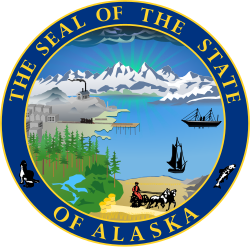History of design
The first governor of the District of Alaska, John Henry Kinkead, designated a seal for the district which featured glaciers, northern lights, igloos and an Inuk person ice fishing. [2]
In 1910, this seal was replaced with a design more representative of the state's industrial and natural wealth. This was done at the request of the Governor of the District of Alaska, Walter Eli Clark, on the grounds that he felt the old seal focussed too much on icebergs, the Northern Lights and Native Americans. [1] Accordingly, he asked an anonymous draftsman in Juneau to design a new Seal, which was subsequently adopted. [1] Today's seal contains rays above the mountains that represent the Alaskan northern lights. The smelter symbolizes mining, the train stands for Alaska's railroads and ships denote transportation by sea. The trees pictured in the seal symbolize the state's wealth of timber, and the farmer, his horse and the three shocks of wheat stand for Alaskan agriculture. The fish and the seals signify the importance of fishing and seal rookeries to Alaska's economy. [3]
The physical seal is officially kept by the Lieutenant Governor of Alaska (formerly known as the Secretary of State) and is responsible for using it to confirm state regulations. [4]
This page is based on this
Wikipedia article Text is available under the
CC BY-SA 4.0 license; additional terms may apply.
Images, videos and audio are available under their respective licenses.



